What SimilarWeb is and how it works
SimilarWeb is a market intelligence platform that provides analytics insights for businesses. Today, it covers 58 different country markets. In the screen below, you can see SimilarWeb’s approach to collecting and analyzing digital data.
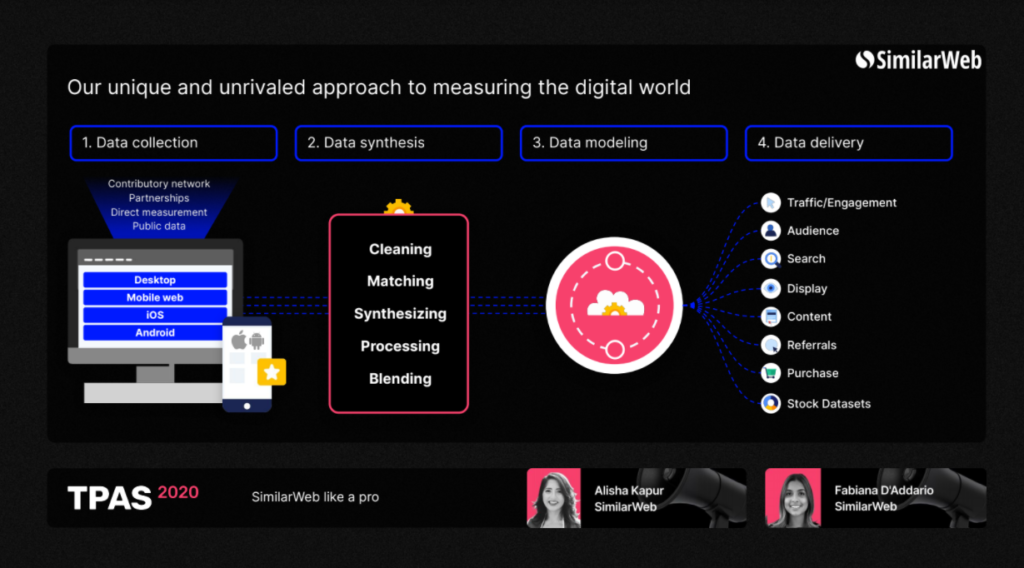
This approach to data methodology consists of four main steps:
- Data collection. SimilarWeb boasts to have created the industry’s most diversified data universe that preserved variety across countries, industries, user groups and devices.
- Data synthesis. It cleans, matches and synthesizes data to prepare for the modeling stage.
- Data modeling. The data is run through machine learning calibration and predictive models to provide an accurate view of the digital world overtime.
- Data delivery. SimilarWeb’s intelligence engine generates powerful insights, while API helps make better decisions.
Understanding the consumer decision journey
SimilarWeb is also useful in improving your business’ performance throughout all stages of the consumer decision journey.

- At the Awareness stage, SimilarWeb provides industry analysis and identifies its key players in a particular geography.
- The Consideration stage allows you to run competitive analysis and check their traffic channels such as SEO, referrals, affiliate marketing, social, etc.
- The Evaluation stage helps understand the website’s audience and engagement level.
- Within the Purchase stage, you will get conversion metrics, including on-site search data.
- The Experience stage allows you to work on your audience’s loyalty retention.
SimilarWeb Pro
SimilarWeb Pro is a widely used platform that gives comprehensive analysis for any site or application on the internet. Fabiana gives an example [5:49] of how you can use SimilarWeb Pro to run web traffic analysis in the case of Booking.com, one of key players in the travel niche. The first indicator to check is marketing channels.
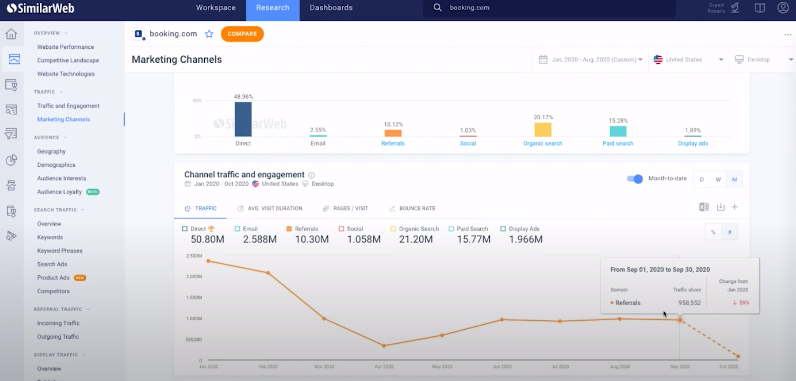
Analyzing traffic sources
Despite the fact that 2020 has been a crazy time for the travel niche due to COVID-19, things are looking promising for Booking.com. So, we see that the biggest traffic sources for the platform this year have been direct, organic search, paid search, and referrals. SimilarWeb also allows you to see how this ratio changed over time. What’s more, you can check Booking.com’s performance against other competitors such as Expedia and Airbnb in this case. SimilarWeb allows users to add up to five websites to an analysis.
Next, we can head into referral traffic to understand where it comes from. SimilarWeb shows different stats such as the number of total referral visits, referral visits over time, referring domains, etc.
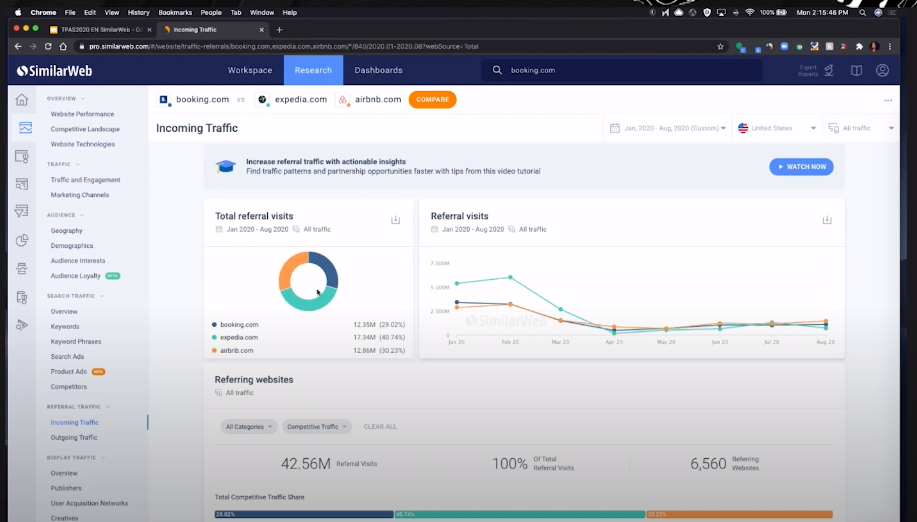
In this case, we see that Expedia owns about 40% of referral visits (Jan 2020 – Aug 2020), Airbnb about 30% of that share and Booking.com owns 29%. All three domains experienced similar traffic changes over time due to COVID-19.
Further below, you can see the list of referring domains and competitive traffic share for each one on the right as well as how it’s changing over time if you click a domain and select down to the dropdown.
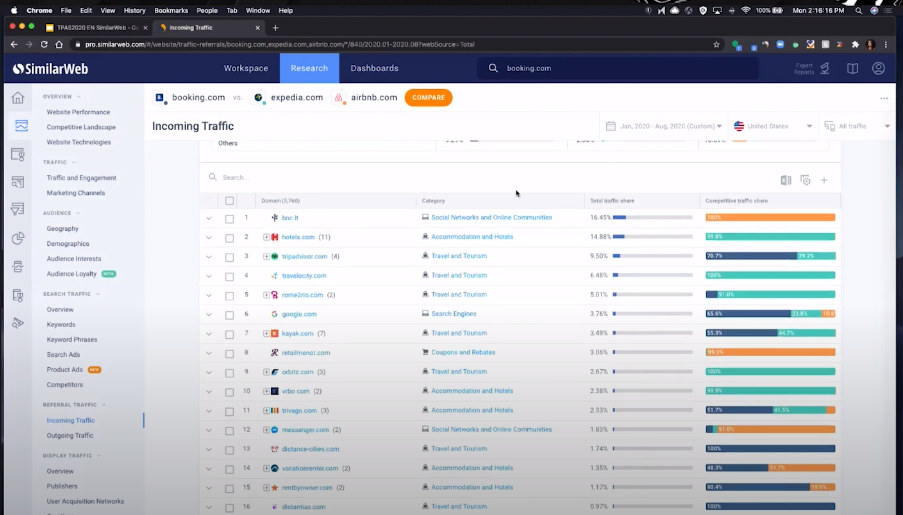
Discovering affiliate opportunities
SimilarWeb offers a lot of ways to discover new affiliate opportunities. In the “Referring websites” section, click “Competitive Traffic” and then “Referral Opportunities” and there you can see all the referrals that are sending traffic to your competitors and not you. Basically, these are potential partners who you can reach out to, and SimilarWeb allows you to add such domains to one partner list, which you can monitor over time. What’s more, the feature of category distribution helps categorize competitors’ traffic, and there are over 170 categories to filter to.
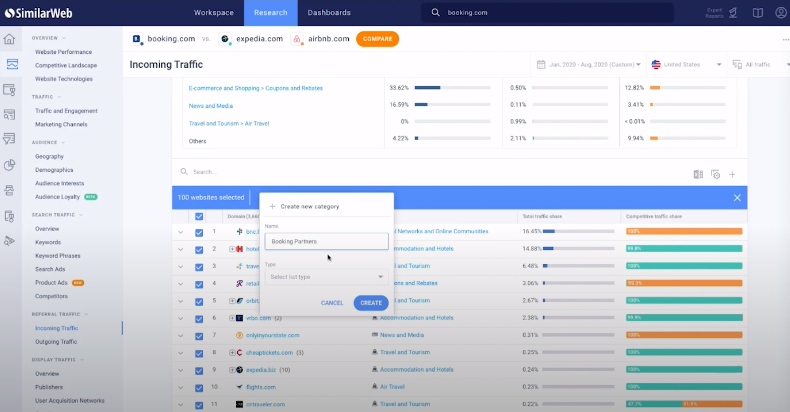
To help understand how it works, Fabiana analyzes [15:02] retailmenot.com, a potential partner for Booking.com. You can see its total visits within the USA, traffic distribution between mobile and desktop, monthly visits over time, unique visitors, duplicated audience, and so on. Some of the most golden metrics for checking a partner’s traffic quality are bounce rate, pages per visit, visit duration. You can also add in other competitors and see how retailmenot.com performs against them.
Monitoring partnerships over time
With SimilarWeb’s arenas, you can set up a competitive set based on your partner list and run web traffic analysis. Choose the primary website, geography, and competitors to start comparison. You’ll be able to see from a benchmark’s perspective visits over time, engagement as well as referrals overview. This is an incredibly useful feature including indicators such as referral opportunities and losses, wins, highly competitive referrals, etc.
SimilarWeb can also help you understand outgoing traffic shares. You can check who your competitors have partnerships with, and whether they’re strong partners themselves, like, how many outgoing visits they send.
You can upload a list of partners you’re currently working with and see if they’re also cooperating with your competitors.
Monitor all these indicators over time with the help of SimilarWeb dashboards. They are highly customizable and contain useful templates to help you discover partnership opportunities. One such example is the affiliate marketing optimization dashboard. There, you select your main website, up to four competitors, and a geography and then you can monitor this channel over time. The dashboard includes metrics such as referrals battleground, top referrals, and referring categories, etc.
Travel Intelligence overview
Travel Intelligence is SimilarWeb’s most granular dataset on the transactional performance of the OTA accommodations and hotel sector. You can monitor total booking volume and market share by company across 56 countries. It’s a great way to identify:
- Key market players
- Top destinations
- Travel trends
- Monthly mobile and desktop bookings
- Consumer behaviour across different geographies
The market intelligence report helps understand destinations at the country, state, and city levels, which makes it stand out from the competition. What’s more, the platform also tracks confirmation “Thank you” pages so that users can see how many bookings were actually confirmed. All in all, it gives valuable insights into the performance of a company as well as destination and origin countries.
To demonstrate how the platform works, Alisha runs a website analysis [28:37] for Booking Holdings. This market intelligence report includes three dashboards: company, country, and destination, which are addressed below.
Company dashboard
Regarding the overall trend of bookings, the company had a drop-off in April due to COVID-19 and then a pretty nice recovery starting May, followed by a dip in bookings at the end of the summer.
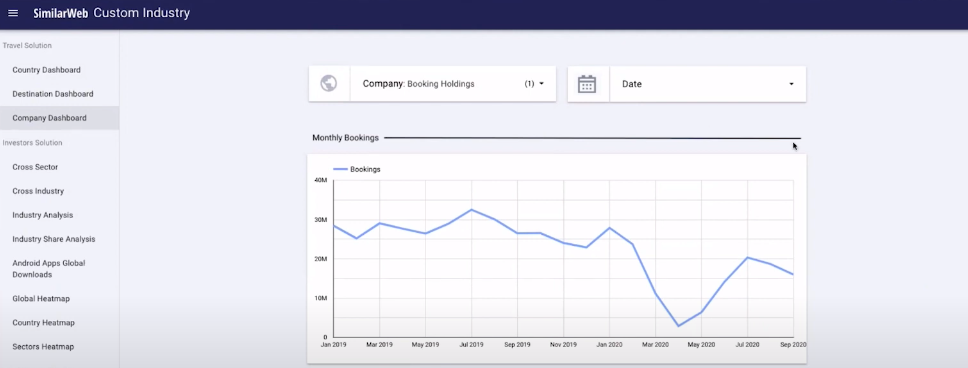
Moving on to top origin and destination markets, Booking Holdings is a diverse company with both origin and destination shares in various countries around the world and a large footprint in Europe (United Kingdom, Germany, France, Spain, Italy, etc.). This feature allows you to understand consumer behaviour across different markets and see where the recovery is happening.
Country dashboard
The country dashboard allows you to have a deeper analysis of origin countries to understand consumer behaviour and recovery trends. Alisha compares [32:01] the company’s performance in the US against the French market.
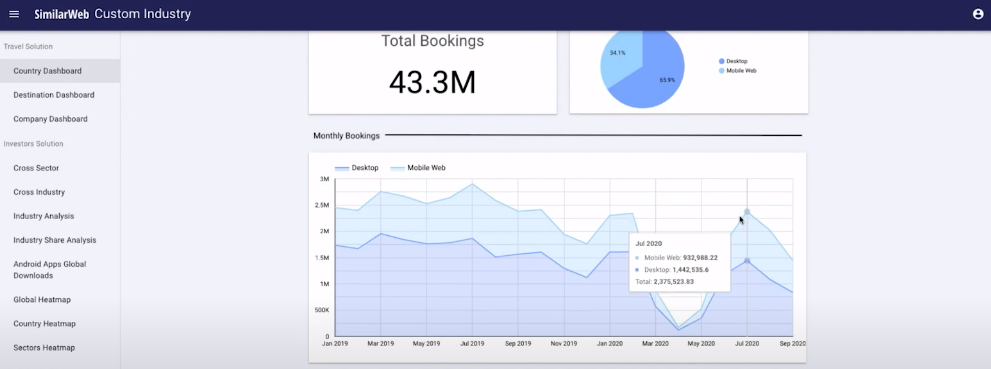
As we can see, France spiked during the summer holiday season and experienced a drop-off in autumn. This is indicative of slightly different recovery trends in France than in the US. Furthermore, if we look at the top destinations for travelers in France in this whole time range, two-thirds of users intended to travel within the country, while in September 2020 domestic tourist spots accounted for 86% of all bookings from France.
To understand what traffic you should optimize your site for, SimilarWeb shows a ratio of mobile and desktop bookings. Whereas formerly people did most reservations through desktop, in the past few months things have changed, with mobile overtaking desktop for the first time ever. However, numbers differ in various geographies. Thus, France saw a 7.9% increase in mobile bookings, while their share at the worldwide level slightly decreased.
SimilarWeb allows you to see who really owns the market. Thus, OTAs (online travel agencies) make for a large proportion of bookings in Europe, with Booking.com being the biggest player (61% of all reservations). The rest goes to Airbnb, Expedia, and smaller OTAs.
Finally, demographics breakout helps understand the consumer base in different geographies with regard to age groups and gender.
Destination dashboard
In the destination dashboard, Alisha demonstrates [36:14] travel trends in Las Vegas, top US destination since the pandemic. The total amount of bookings for the specified period is 7.7 million. We can see that Las Vegas is heavily OTA-dominated, as almost three quarters of bookings are carried through online travel agencies. The city also has a nice recovery starting May with a fall-off between August and September. As for top origin markets, which are where users make bookings from, most people visiting Las Vegas are from the US.
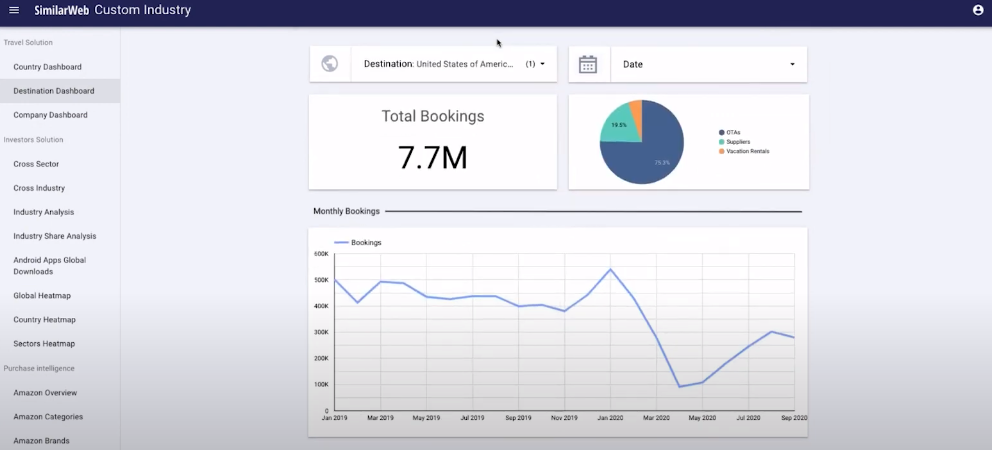
SimilarWeb also helps gain insights into top hotels booked on OTAs. Thus, four of the top 100 most often booked hotels are owned by Metro-Goldwyn-Mayer (MGM), and the rest belongs to Caesars, its main competitor, or independent operators.
How to use SimilarWeb like a pro
All in all, SimilarWeb is a comprehensive tool for website analysis that can help you gain insights into competitors’ traffic, discover new partnership opportunities and explore travel trends in individual regions as well as across the world. SimilarWeb is one of the only data sets of its kind on the market, with which you can identify key players in the niche and improve your marketing strategy accordingly.
Presentation
You can download the presentation from the webinar at this link.



